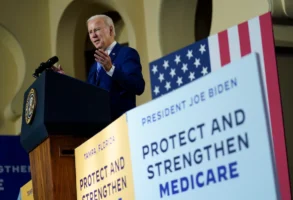Published March 20, 2016
Review: THE FIGHT TO VOTE by Michael Waldman
Simon & Schuster, 368 pages, $28
Who’s rigging our elections? Ask Republicans and they’ll insist that Democrats promote voter fraud through early balloting, same-day registration and lax oversight that encourages illegal immigrants to vote. Nonsense, Democrats will say. It’s the GOP that’s trying to disenfranchise young, poor and minority voters by requiring picture IDs at polling places and bringing court cases intended to eliminate federal oversight of voting practices in many Southern states.
As Michael Waldman, president of the Brennan Center for Justice at NYU Law School, reminds us in “The Fight to Vote,” such disputes are not new: Voter eligibility and qualifications have been at the heart of the struggle for American democracy from its outset. After the Revolutionary War, Pennsylvanians debated for 14 years over who should be able to vote, with opponents of universal suffrage like Benjamin Rush deriding it as “a mobocracy.” The book is an engaging, concise history of American voting practices, and despite a heavily partisan treatment of today’s “voting wars,” it offers many useful reforms that advocates on both sides of the aisle should consider.
The first two sections of the book trace American voting patterns from the Founding to the early Progressive Era. Mr. Waldman shows how the right to vote was gradually extended from property owners to, by the mid-1830s, almost all free white men. At every turn, there was opposition to expanding the right to vote.
Many early Americans thought liberty was inextricably linked with property and thus supported restricting the vote to the educated and well-to-do. Mr. Waldman quotes James Kent, a leading law professor opposed to expanding the right to vote in New York in 1821. Attacking rule by “the motley and undefinable population of crowded ports,” he contended that “the tendency of universal suffrage, is to jeopardize the rights of property, and the principles of liberty.” Those who believe universal suffrage is the natural course of a democracy will find many such examples of contrary thought.
Mr. Waldman’s discussion of how the franchise was extended to free blacks in the South after the Civil War, culminating in the ratification of the 15th Amendment in 1870, and then effectively undone in the early Jim Crow era from 1890 to 1910, depicts the ambitions and pressures of that time all too well. He shows how Republicans, motivated in equal parts by idealism and crass power politics (they rightly expected the newly enfranchised blacks to vote for the party that had freed them), first pushed voting rights forward and then meekly allowed them to be eroded. The quasi-guerrilla warfare waged by opponents of Reconstruction had persuaded them that the costs of enfranchising the newly freed slaves far outweighed the benefits.
Mr. Waldman’s central thesis is that money and democratic politics have always gone together. Expanded democracy is essential to the sort of redistributive state the author clearly endorses—and those who oppose such policies have often tried to limit the franchise to prevent such measures from being enacted. He quotes the noted 19th-century historian Francis Parkman arguing in 1878 that universal suffrage had become “a questionable blessing” because voters now were “restless workmen, foreigners for the most part, to whom liberty means license and politics means plunder.”
Money is front and center in Mr. Waldman’s treatment of the efforts to restrict voting in the Gilded Age and the Progressive Era. Staples of today’s democracy, such as voter registration and government-issued ballots, are products of this age. Proponents of these policies argued that they were necessary to combat voter fraud, especially in America’s growing cities, which were teeming with immigrants, most of whom were not citizens. Mr. Waldman offers a different view, suggesting that these measures were intended to tilt political combat in favor of wealthier elites and served to reduce citizen participation in elections. He laments that voting rates started to decline in this era, but he doesn’t really consider the possibility that near universal participation was an illusion created by rampant fraud. As he notes in one example from a 1904 Colorado election: “One witness testified under oath that he voted 125 times in the city of Denver.”
The chapter devoted to recounting the fight for, and the passage of, the Voting Rights Act of 1965 is the book’s best and most moving. Mr. Waldman’s gripping narrative explains how this landmark law came to be enacted. The struggle culminates with President Johnson delivering a speech written in one day by a hung-over Richard Goodwin—the “liberal Jew [with] his hand on the pulse of America,” according to the president—ending with Johnson uttering the words of the civil-rights movement itself: “We shall overcome.”
But Mr. Waldman’s partisan perspective on the current voting wars mars the book. He sharply criticizes those who support voter ID laws, contending that their stated motivation—stopping voter fraud—is merely an excuse for denying Democratic-leaning constituencies the ballot. He reserves special ire for the Supreme Court, which in recent years has opposed his views in cases like Citizens United, which ruled that a 1907 congressional ban on corporate contributions to political campaigns was unconstitutional, and Shelby County v. Holder, which overturned Section 4 of the Voting Rights Act of 1965—Mr. Waldman uses the word “eviscerated.”
Yet Mr. Waldman’s proposed reforms deserve serious consideration. Reforming felon disenfranchisement laws, for example, is supported by figures on the right and the left. Providing for universally available picture IDs and electronic, picture-enabled voting rolls would be an interesting left-right compromise to address both sides’ concerns. Replacing easy-to-manipulate early absentee voting with strictly supervised in-person balloting is another idea with potential. Mr. Waldman would have better served his readers had he spent more time explaining these smart policy proposals rather than engaging in an anticonservative jeremiad.
Mr. Olsen is a senior fellow at the Ethics and Public Policy Center.








